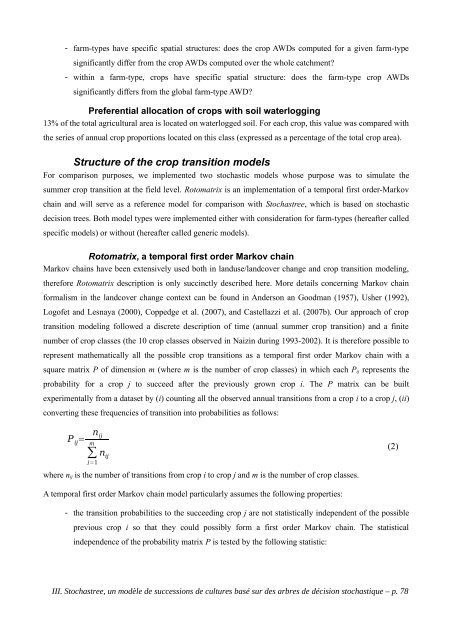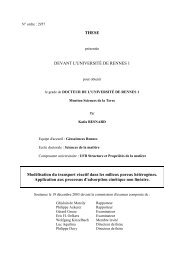Paysages virtuels et analyse de scénarios pour évaluer les impacts ...
Paysages virtuels et analyse de scénarios pour évaluer les impacts ...
Paysages virtuels et analyse de scénarios pour évaluer les impacts ...
Create successful ePaper yourself
Turn your PDF publications into a flip-book with our unique Google optimized e-Paper software.
- farm-types have specific spatial structures: does the crop AWDs computed for a given farm-type<br />
significantly differ from the crop AWDs computed over the whole catchment?<br />
- within a farm-type, crops have specific spatial structure: does the farm-type crop AWDs<br />
significantly differs from the global farm-type AWD?<br />
Preferential allocation of crops with soil waterlogging<br />
13% of the total agricultural area is located on waterlogged soil. For each crop, this value was compared with<br />
the series of annual crop proportions located on this class (expressed as a percentage of the total crop area).<br />
Structure of the crop transition mo<strong>de</strong>ls<br />
For comparison purposes, we implemented two stochastic mo<strong>de</strong>ls whose purpose was to simulate the<br />
summer crop transition at the field level. Rotomatrix is an implementation of a temporal first or<strong>de</strong>r-Markov<br />
chain and will serve as a reference mo<strong>de</strong>l for comparison with Stochastree, which is based on stochastic<br />
<strong>de</strong>cision trees. Both mo<strong>de</strong>l types were implemented either with consi<strong>de</strong>ration for farm-types (hereafter called<br />
specific mo<strong>de</strong>ls) or without (hereafter called generic mo<strong>de</strong>ls).<br />
Rotomatrix, a temporal first or<strong>de</strong>r Markov chain<br />
Markov chains have been extensively used both in landuse/landcover change and crop transition mo<strong>de</strong>ling,<br />
therefore Rotomatrix <strong>de</strong>scription is only succinctly <strong>de</strong>scribed here. More d<strong>et</strong>ails concerning Markov chain<br />
formalism in the landcover change context can be found in An<strong>de</strong>rson an Goodman (1957), Usher (1992),<br />
Logof<strong>et</strong> and Lesnaya (2000), Coppedge <strong>et</strong> al. (2007), and Castellazzi <strong>et</strong> al. (2007b). Our approach of crop<br />
transition mo<strong>de</strong>ling followed a discr<strong>et</strong>e <strong>de</strong>scription of time (annual summer crop transition) and a finite<br />
number of crop classes (the 10 crop classes observed in Naizin during 1993-2002). It is therefore possible to<br />
represent mathematically all the possible crop transitions as a temporal first or<strong>de</strong>r Markov chain with a<br />
square matrix P of dimension m (where m is the number of crop classes) in which each Pij represents the<br />
probability for a crop j to succeed after the previously grown crop i. The P matrix can be built<br />
experimentally from a datas<strong>et</strong> by (i) counting all the observed annual transitions from a crop i to a crop j, (ii)<br />
converting these frequencies of transition into probabilities as follows:<br />
P ij = n ij<br />
m<br />
∑ j=1<br />
n ij<br />
where nij is the number of transitions from crop i to crop j and m is the number of crop classes.<br />
A temporal first or<strong>de</strong>r Markov chain mo<strong>de</strong>l particularly assumes the following properties:<br />
- the transition probabilities to the succeeding crop j are not statistically in<strong>de</strong>pen<strong>de</strong>nt of the possible<br />
previous crop i so that they could possibly form a first or<strong>de</strong>r Markov chain. The statistical<br />
in<strong>de</strong>pen<strong>de</strong>nce of the probability matrix P is tested by the following statistic:<br />
III. Stochastree, un modèle <strong>de</strong> successions <strong>de</strong> cultures basé sur <strong>de</strong>s arbres <strong>de</strong> décision stochastique – p. 78<br />
(2)



